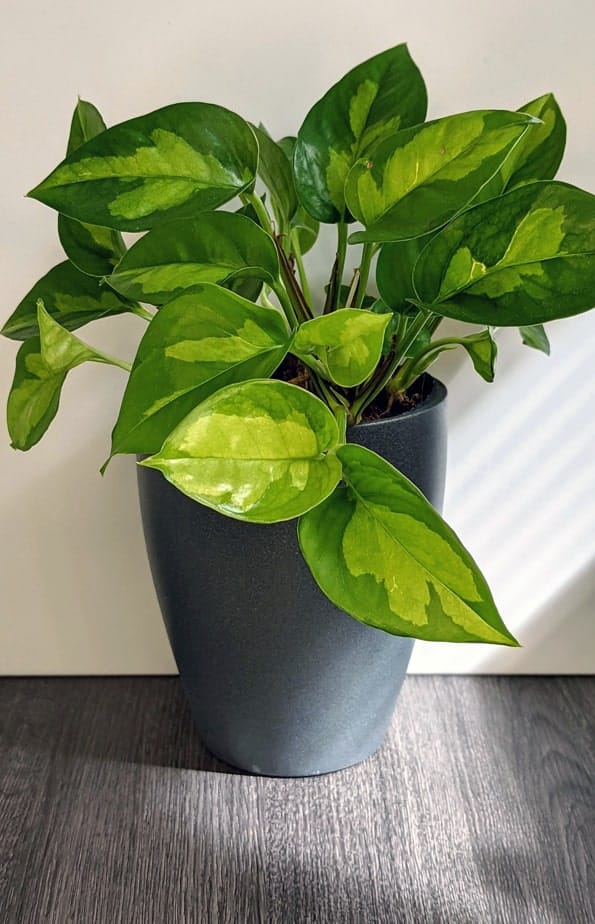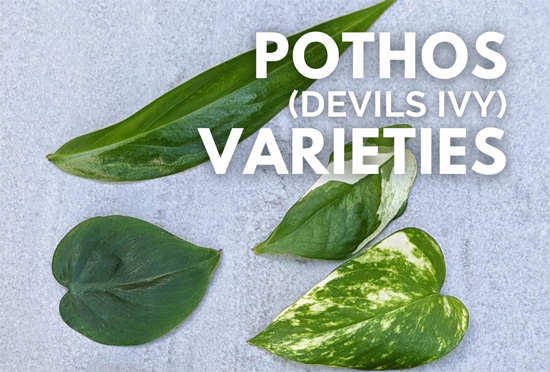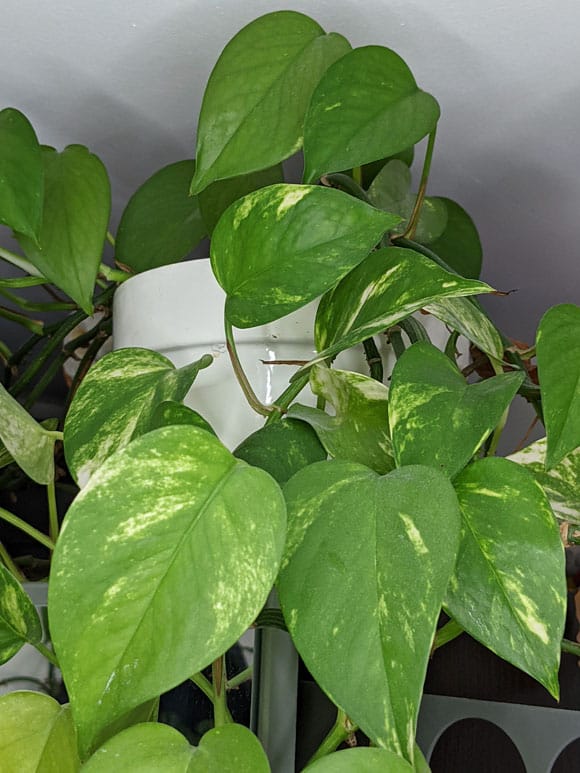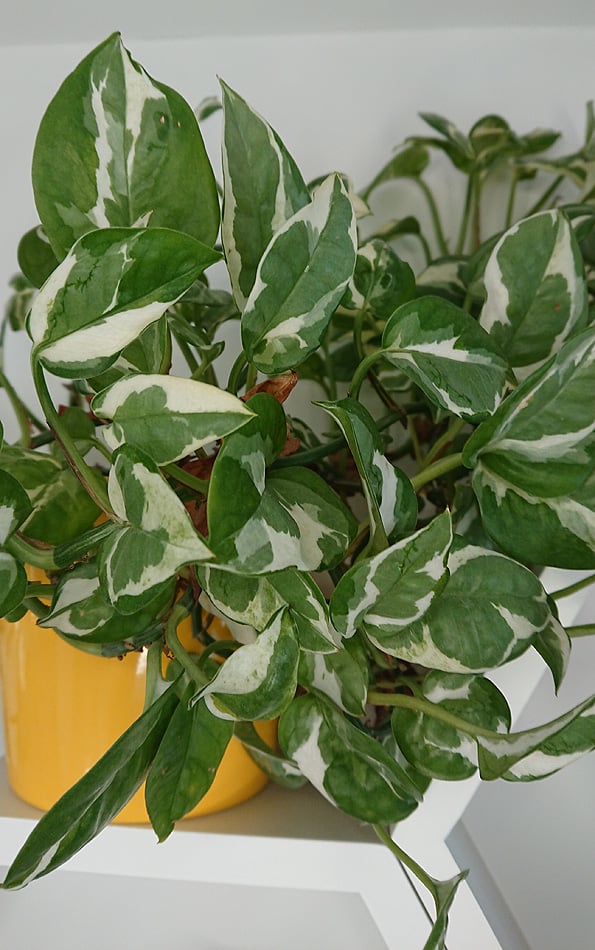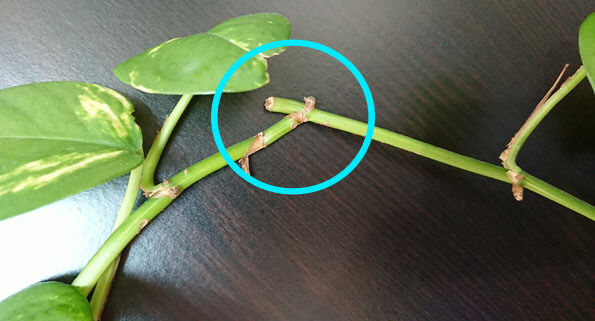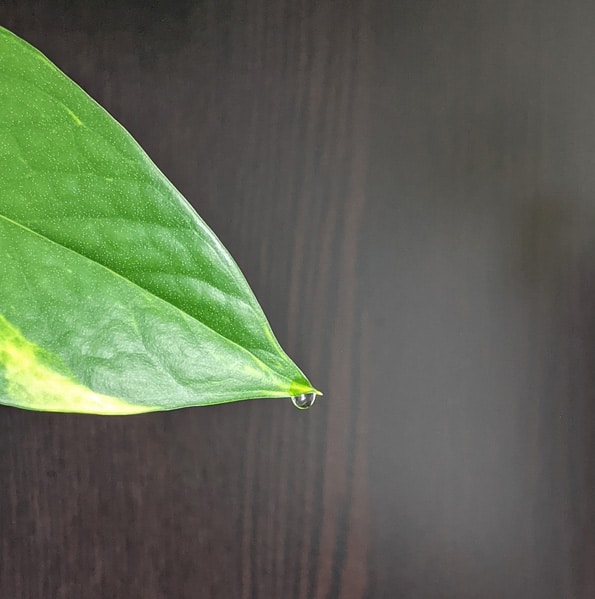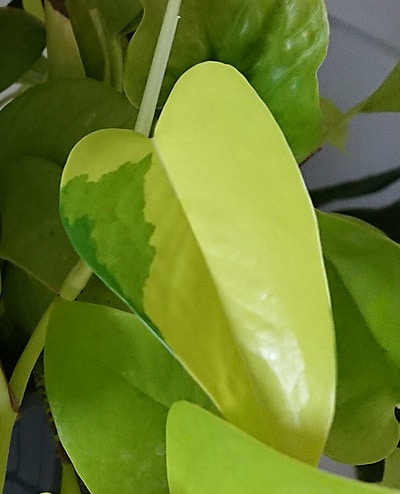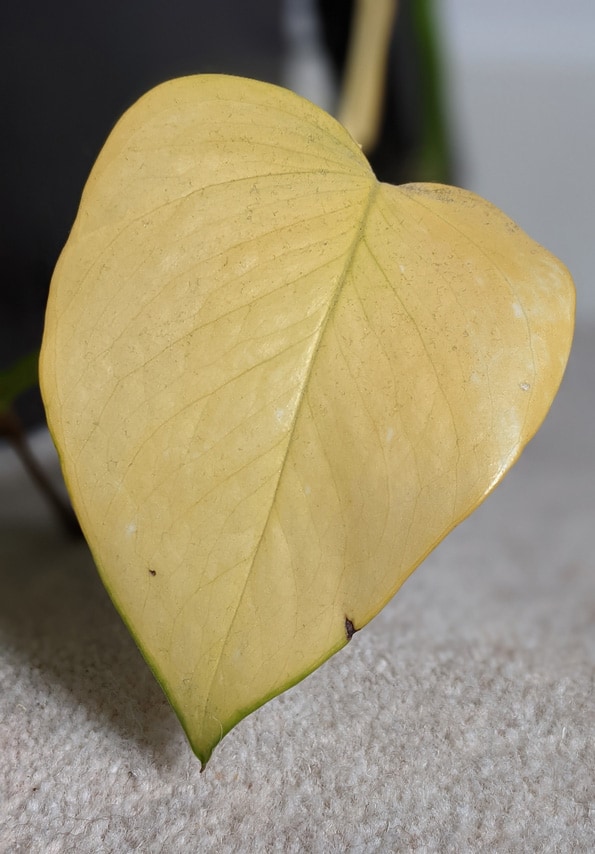Pothos or Devils Ivy are easy going houseplants that are almost idiot-proof to grow indoors. They can live in homes, offices or even a shopping mall. Pothos Plants are not fussy!
Plant care is easy and problems are usually few and far between. And we should know as between us we have at least eight of these handsome plants.
Given time, a plant will creep, trail and cling around anything in its path, spreading and sliding towards sources of light. If this trailing look isn't for you, then the good news is that it also looks beautiful growing up a moss pole.
Pothos plant care is easy to get right - give a little light, some water and warmth and it looks after itself.
It used to be known scientifically as Scindapsus aureau or Phaphidophora aureu. More recently, it can still be known as Scindapsus aureus in some parts of Europe.
However, the Botanist of today will call it Epipremnum aureum. So this is largely the "correct name" that should be used.
The common names it goes by are just as varied, Devil's Ivy, Golden Pothos, Ivy Arum and Taro Vine to name just a few.
So even if you know it by something else, in our article here to keep things simple, we will use its current scientific name, Epipremnum aureum and its most popular common names, of Pothos and Devils Ivy.
These are popular houseplants that have been around for years, so there are many different Pothos Varieties out there now that you can buy.
So many in fact we created a separate article which gives you the details of the 14 popular types you can get your hands on.
Although most have heart shaped leaf, there are a lot of different markings to pick from - Check out our 14 Pothos (Devil's Ivy) Varieties guide to learn more.
These are some of the easiest houseplants you can own. All you need to do is follow the simple care instructions, which will ensure you have stress free growing experience. All you need to know is coming up next.

Hi, I'm Tom!
If you're like me and enjoy the challenge of growing houseplants and getting them to thrive, then Ourhouseplants can help. This website shares my knowledge and years of growing plants and provides (hopefully) helpful advice on properly caring for your indoor plant friends.
Although it can cope with a lot of different light levels, bright light would be best for your Pothos plant. Growth will be slower if you choose a very dark spot, and over time this will also create sparse "vines" with leaves quite far apart.
Very bright areas with strong sunlight beaming onto the leaves should also be avoided because this will eventually destroy the plant.
Try to aim for any spot in your home where you could sit and comfortably read a book for most of the day. If you struggle to see the words or have to squint because it's too bright, your plant will not be happy either.
Devil's Ivy is versatile and adaptable. This one is on top of a cupboard growing in low-light conditions.
Water your Pothos regularly during the growing seasons and always a lot less in Winter. It has a level of drought tolerance, so your plant won't mind being under watered. But over watering needs to be avoided, otherwise you risk root rot setting in.
A drainage hole in the growing container so water can escape will help a little, but it's really important to let the growing medium dry out at least a little between waterings.
Don't Forget - The soil should never be soggy or wet. If you've given too much, pour any excess water away.
A good soak every week is likely ideal. However, many factors play a part, with plants in warm rooms and lots of light needing more water than those in cooler spots and receiving less light.
If given a choice, your Devils Ivy would choose high humidity due to being tropical plants. However, it's not vital for a healthy plant and they should be equally at home in a location with lower humidity levels.
There is no need to feed unless the plant is growing. If you're able to, give your plant a light feed once every two or three months over the Spring and Summer using a general all-purpose liquid fertilizer.
They're not heavy feeders and you really only need to do it semi-regularly, but you'll still get fab results.
N'joy Pothos in a yellow pot with a number of trailing vines.
A reasonable warm temperature is needed here. No lower than 10°C (50°F) in Winter and ideally between 15°C (59°F) and 25°C (77°F) in the other seasons.
They do well in a small pot, so you only need to think about repotting your Pothos when the roots are so congested the plant starts to suffer. This will take at least a few years (maybe more) to happen.
No Really...
I'm not kidding about waiting years before you need to repot these plants. My Golden Pothos has been in the same pot for the last 5 (coming up to 6) years and it's still growing like crazy.
The most obvious sign of a repot being needed is when it isn't growing anymore and it's Summer (little to no growth in Winter is normal).
When you come to do it, just everyday potting soil is fine. They do well in alternative growing mediums like coconut coir or a DIY potting mix.
Propagating Pothos is incredibly easy. If you want more plants, you should give it a go as it's really difficult to go wrong.
In Spring or Summer, create propagation material by cutting off the tips just below a "node" to create stem cuttings. You then put them in water until they grow roots, or push the cuttings directly into pots of moist compost. They root easily so you should have a good success rate.
Once you get some
root growth establishing, new leaves will start appearing soon afterwards. If you opted for water propagation first it's at this stage you can move them on into some fresh potting soil.
If you're not confident in doing it or don't understand what we've said, then watch our quick video for more. Although we're using a Satin Pothos (Scindapsus Pictus) for the clip, the way to do it is identical.
Watch our super short YouTube video if you want a visual propagation guide, including where to cut the stems and clear pictures of the leaf nodes.
Pothos is normally a quick growing houseplant providing you treat it well. Different varieties grow at different speeds, with the N'Joy potentially growing the slowest because it has smaller leaves.
All varieties will have slow growth or will stop growing entirely if poor care is provided or if its too cold, like if it's over Winter.
This depends on how you're growing Pothos and the variety you have. So to address this it's best to explain a little about the eventual length of the vines first. They can reach impressive lengths out in the wild, up to 20m / 66ft.
Devils Ivy Growth Habits
I've found that 'N'Joy' Pothos and the Cebu Blue Pothos stay fairly compact with a little pruning. Neon and Marble Queen Pothos, are a little more adventurous and need more clipping.
The Golden and Jade Pothos on the other hand need a lot more pruning and training otherwise they can quickly spread and look out of control.
They can get very long indoors too but this is rare because although the creeping habit is part of the charm, many homeowners will prune when they become too long and unruly. Ultimately this means the plant can be as tall or as short as you want it to be.
At one stage, this "out of control" look was a highly desirable feature (because you could train its long vines above windows and beams to soften hard lines and edges). Now this can be looked upon as untidy and messy, especially in a modern home.
If this trailing look isn't for you, then the good news is that it looks beautiful growing up a moss stick. To those who don't know what this is, it's a vertical hollow tube made of plastic mesh with wide holes, the inside of the tube is typically filled with moss like material.
The entire "stick" is then placed and firmed into the pot with soil and over time the stick becomes covered and hidden by the growing plant as it grows up it. Once it can climb, the plant will produce aerial roots that support the growth.
A number of a moss sticks for sale
Eventually the pothos vines will hide the supporting moss completely. Thereby the moss stick turns a normally low growing and spreading plant into a compact and vertical column of greenery. Genius.
You can normally buy these sticks from stores if you look hard enough or instead choose to let Pothos clamber over your entire home, failing that you can pinch out the tips regularly and keep it neat and tidy in a simple container.
Moss Sticks for Sale - Struggling to find moss sticks for your plants? Then we'll give the thumbs up to these ones on Amazon.
Getting flowers on indoor plants is very rare. To be fair this doesn't really matter, it's only because of the beautiful foliage that these plants are grown indoors.
The leaves and stems have a sap that contains Insoluble calcium oxalates. If a cat, dog or person ingests this it can result in painful lips, mouth and tongue. If a fair amount of the plant is eaten more significant symptoms such as vomiting are common.
- Just like English Ivy, you can pinch out the tips of the vines which will create a more compact and bushier plant.
-
Each plant will produce several vines which twine together, this can look quite messy so every now and again gently untangle them.
You can prune back most of your plant to reinvigorate it
- If your Pothos reaches a good age, then a common problem you'll face is bare and leafless vines over large sections. At this point, you could either take cuttings to create brand new plants. Or if you're particularly fond of your existing one, you can cut back most of the plant's vine back towards its base to reinvigorate it.
Make the cut just past a leaf node and a new shoot should sprout within a few weeks.
As an example, we cut our plant back as shown in the photo below. The stump in the middle of the blue circle was where we made the cut. The growth on the right was the existing vine and the growth on the left is the new sprouting vine. It grew robustly and produced a lot of new leaves along the way.
Golden pothos plants can grow long vines that can be easily pruned.
Dripping / Crying Pothos leaves (guttation)
After a Pothos plant has been watered well, in warmer months when you wake in the morning you may find water like droplets have formed and collected at the leaf tips. This is know scientifically as guttation and is almost always harmless.
Many houseplants "cry" or drip small amounts of water from the leaf tips.
We say almost because the liquid has leaked out of the tiny pores on the undersides of the leaves called stomata, essentially it's mostly water, but you have to remember it has come from inside the houseplant. This means small concentrations of sugars or waste material may also have leaked out with the water.
There is no need for major concern as guttation is usually only temporary, once the growing medium has dried out after a few days, it will stop. In the meantime just catch the drips with a tissue rather than trying to drink them or something silly.
Black spots on the leaves / Yellow leaves
This is caused by overwatering. The soil should be moist for much of the time, but never let it sit in water.
My variegated plant is producing solid green leaves
When treated as indoor plants, some loss of variegation in the Golden Pothos and Marble Queen is reasonably common.
There is a slim possibility it's happening because the light levels are too low and therefore it's not getting enough light hitting the leaves. But this isn't usually a problem for these plants as they hold on to any variegation fairly well even in low light conditions.
This Neon should have completely lime green leaves. These spreading splotches of darker green shouldn't be here.
Instead, it's more likely the plant is just reverting back to it's original "DNA" makeup, which is the solid green, non variegated type. You can see it happening in the photo above with this Neon Pothos.
One or two leaves can be ignored (or just snipped off). If all new growth on that vine is like this (and you don't like it), you will need to snip off the vine back to where the leaves are "normal". The hope here is that when it starts growing more leaves, the next ones will have the familiar markings again.
Variegation fading
Pothos is adaptable to darker spots in your home, but if it's really dark, the variegation will gradually fade a little. Move it to a place with some bright indirect light and over a few months it should produce new growth that restores the variegated look.
Leggy looking Pothos plant with yellow leaves
The oldest leaves will yellow and fall over time and this is normal. The process will happen more frequently, and with random leaves further down the vines, if you overwatered or underwatered on a regular basis.
Too much light, and we're talking direct sunlight here, can also trigger yellowing. Use this houseplants main selling point of being low light tolerant and swap it with a plant that wants more sun.
Lots of yellow leaves can be a sign of soggy soil
Over a long period this type of care will ruin and destroy the look of the plant and you'll end up with bare and empty vines. If this happens you can either take cuttings from the tips to produce new plants or cut back everything to start again.
Pothos leaves have dry brown edges / Leaves drooping.
This is caused by underwatering. Give it a good drink and the dropping will go within 24 hours. The brown leaf tips can be cut off.
Pale / Translucence / Scorched leaves
This is caused by too much light, move it to a darker place or provide some shielding.
Credit for "Marble Queen" Gallery - LucaLuca
Credit for Pothos "Aureum" growing over a celling - Jerzy Opioła
Credit for Pothos Neon - Gallery - David J. Stang
